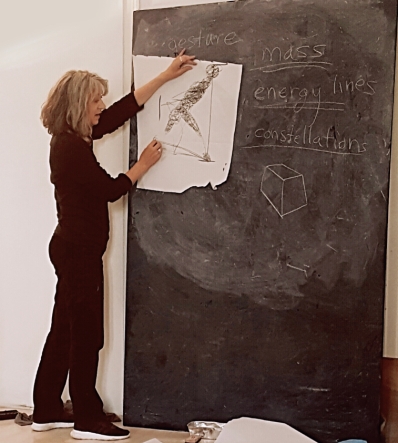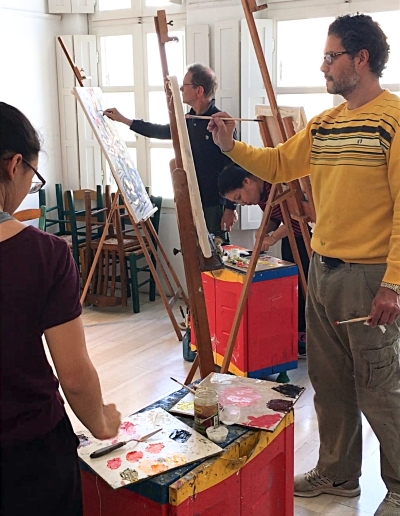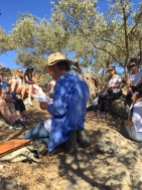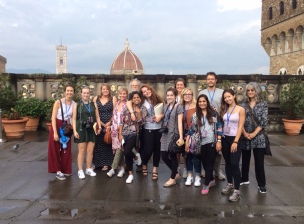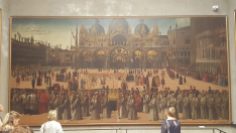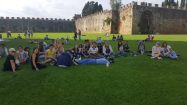Which Ancient Philosopher Are You?
31, December 2019 § 2 Comments
Epicureanism. Living gracefully within the garden of nature.
The Aegean Center students and staff spend a month each fall living and studying in the Villa Rospigloisi, in Pistoia, Italy. Besides classes in drawing and photography, we learn about Renaissance art and travel most days to see masterworks, returning with gratitude each evening to our villa in the hills. We often linger in the garden in the hours before dinner, watching the light play over the 400 year old magnolia trees, listening to the fountain splash and enjoying the aroma of food coming from the kitchen. We have few distractions, plenty of time to converse, and delicious home cooked meals. The combination of study and simple living create a joyous and rewarding month.
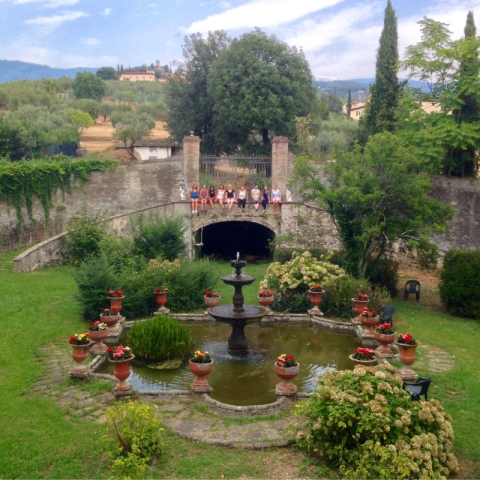 Our Villa Garden in Tuscany
Our Villa Garden in Tuscany
The fact that we are studying in Italy and Greece compels me to introduce a short conversation about ancient philosophers to my students. To make this interesting we read short synopses of seven different philosophies of the ancient world and see which of these resonates with their ideas of how to live a good life. Through a series of questions most of my students this term decided that they identified with Epicureanism. One student decided he was a nihilist, though that wasn’t on the list, and a few were drawn to Neoplatonism.
Epicurus was a 3rd BCE philosopher who believed that through elimination of fears and desires (ataraxia) people would be free to pursue simple pleasures to which they are naturally drawn. His followers were known as the Garden People and worked to banish superstition and cultivate a rational understanding of nature. Unlike many other philosophical discourses, women were allowed and urged to join his circle. Epicureans felt that discovering simple pleasures and living a prudent life leads to the greatest social happiness, that understanding the power of living within nature’s limits was essential. The word Epicureanism is misunderstood now as advocating hedonism but the philosopher himself said that a person can only be happy and free by living wisely, soberly, and morally. He said, “Nothing is enough for the man for whom enough is too little”. Our intention is to create an arts program with echos of this joyful search for individual happiness. We stress living with few material requirements, eating food prepared with pure ingredients and being in nature. We have no pretensions to luxury and yet we provide a wonderfully rich and fruitful atmosphere in which students can achieve their best . When simple wants are satisfied we have a deeper appreciation for the aesthetics aspects of life, of beauty, of art.
 Epicurus
Epicurus
In contrast to my students, I tend toward the Stoic philosophy. Again, modern understanding of this philosophy misinterprets Stoicism as merely censoring strong emotions. Marcus Aurelius and Epitectus elucidate the philosophy of Stoicism as a guide to find peace; integrity being the chief good. Epitectus said, ““Happiness and freedom begin with a clear understanding of one principle: Some things are within our control, and some things are not. It is only after you have faced up to this fundamental rule and learned to distinguish between what you can and can’t control that inner tranquility and outer effectiveness become possible.” What he believed was true education consists in recognizing that each individual has their own will and cannot be compelled or hindered by anything external. He felt that individuals are not responsible for the thoughts that arrive in their consciousnesses though they are completely responsible for the way in which they use them. “Two maxims,” Epictetus wrote, “we must ever bear in mind—that apart from the will there is nothing good or bad, and that we must not try to anticipate or to direct events, but merely to accept them with intelligence.”
 Filigree of Wildflowers on Paros
Filigree of Wildflowers on Paros
And, “Wisdom means understanding without any doubt that circumstances do not rise to meet our expectations. Events happen as they may. People behave as they will.” Finding that my ideals on how to live aligned best with the Stoics I also realised it aids my teaching; empowering me to honour each individual‘s place in the hierarchy of learning, reconfirming that competition has never been an effective teaching tool. I also recognise that what I say and what I teach will be taken by each student to mean what they interpret it to be and not always what I have said. Patience and being an attentive listener are paramount in a teacher but Stoicism also illustrates that 14 different students will have 14 different approaches to a given lesson. Each student will need specific help to elicit their best qualities. It’s not about meeting my standards as much as it is about their comprehension. And, of course, a teacher must accept that each group has its own personality. Fortunately in this group, they were mostly Epicureans by nature.
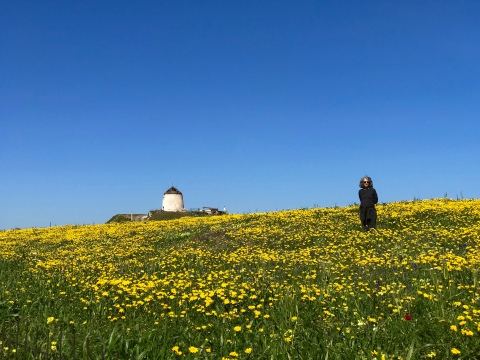 Yellow & Blue Paros Spring
Yellow & Blue Paros Spring
Raphael & 北斎
15, August 2017 § Leave a comment
Raphael’s Drawings: at the Ashmolean & Hokusai: Beyond the Great Wave
At the end of the session this last spring John and I traveled to England to spend a few days in Oxford. We went to see a show of Raphael’s drawings at the Ashmolean, a collection of over hundred and twenty of his original works of art. Drawing exhibitions are far and few between and I was particularly anxious to see this one because Raphael’s draftsmanship is extraordinary and difficult to find and see in person.
It has been said that drawing, within the visual arts, holds the position of being closest to pure thought. (Elderfield) In this sense the drawings allow us to see inside Raphael’s mind as he composed images which would evolve into paintings, frescoes and tapestries. His exploratory line and his imaginative thought process are clearly on view in these works. You feel him working through ideas, expressing emotion with a variety of poses and exploring specific narratives. His drawings are derived from models, imagination, and sometimes from memory. What struck me most was the delicacy and fineness of his workmanship, the exquisite details and the accuracy of his line, his potent understanding of how light describes form. I learned that he often used a stylus to sketch out the preliminary form on the paper before beginning the drawing. This was called a blind line because it did not leave a mark. The drawing was then refined with either metal-point, red chalk, or charcoal. Exploring the spiraling tensions and revealing a staggering knowledge of anatomy he amplified the composition with interlocking negative space and groupings of figures. He was able to reveal the emotional quality of the figures with a minimum of information, sometimes showing only the back of a head or a gesture of the hand to communicate the mood. With rhythm, geometry, and poetry of line his drawings become a testament to the human form as an expression of life force.
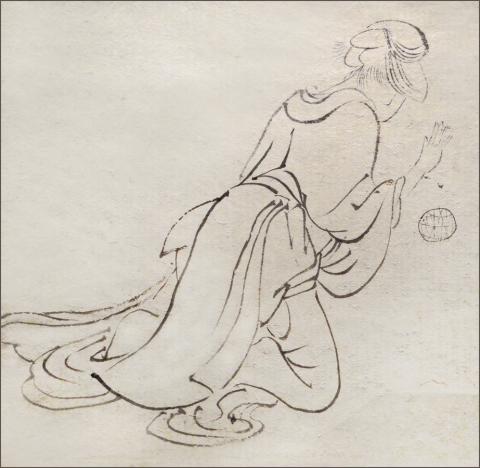
On the way back to Athens we stopped in London and were lucky enough to see the exhibition “Hokusai: Beyond the Great Wave” at the British Museum. This artist’s encyclopedic knowledge of nature is on show with many drawings done with ink and brush, woodblock and illustrated books. Again I was struck by the detail and careful renderings, the delicacy of his work. I think it was Ruskin who said that in fine art there must be something “fine” and I thought once again, looking at Hokusai, that perhaps this is something we’re missing in much of contemporary art. It seems that the muscular, the shocking and the mundane have more value to us than careful observation and recording of form which is so lovingly revealed in these masterworks. Although the artists lived two and a half centuries apart and on two different continents, although they depict two different cultures, there are common elements to their work. Both artists express the inexpressible through the twisting forms of human anatomy, pushing to discover at some level our common humanity and our extraordinary capacity to endure. Meticulous, patient observation combined with imagination and the desire to reveal truth is the binding principle that brings these two artists forward into our world with enduring quality.
Jane Morris Pack

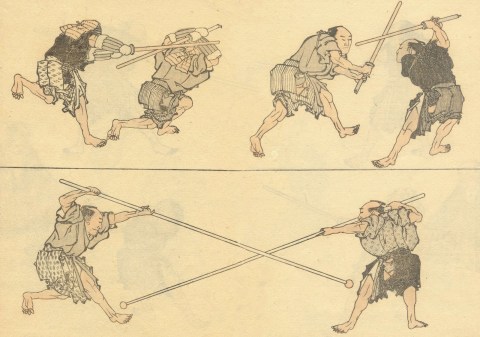


Εγκύκλιο Παιδεία • Liberal Arts
3, February 2017 § 2 Comments
“When we ask about the relationship of a liberal education to citizenship, we are asking a question with a long history in the Western philosophical tradition. We are drawing on Socrates’ concept of ‘the examined life,’ on Aristotle’s notions of reflective citizenship, and above all on Greek and Roman Stoic notions of an education that is ‘liberal’ in that it liberates the mind from bondage of habit and custom, producing people who can function with sensitivity and alertness as citizens of the whole world.” –Martha Nussbaum, Cultivating Humanity: A Classical Defense of Reform in Liberal Education, 1998
 Seven Liberal Arts: Francesco Pesellino: 1422-1457 Florence
Seven Liberal Arts: Francesco Pesellino: 1422-1457 Florence
While hoping to find a way to take a much needed sabbatical many years ago I made some phone calls in search for a person to take over my job for a semester. I talked to a woman who taught at a well known academy in the States, someone who I felt could teach drawing and painting simultaneously as I had been doing for years at the Aegean Center. I gave her the outline of the program; a three month course, in Greece, teaching 20 hours a week, covering the gamut from printmaking to oil painting. She brushed aside my inquiry but not because she felt the weight of long hours of teaching, or because the responsibilities were onerous, but because she would need to teach drawing and painting concurrently. She said that a student needed a full year of basic drawing, followed by a full year of figure drawing before they should be allowed to touch a brush. When I explained that being a single semester abroad program prevented us from spreading out the curriculum in this way she dumbfounded me with her response. “Well”‘ she said, “I consider myself a fascist when it comes to art instruction”. I thanked her for her time and promptly hung up.
In relating this story to students I often wondered whether the fascist intent was sanctioned by her academy or if it was just her own perverse mindset. I have unfortunately seen and heard of teachers who felt their method was uniquely correct and had no tolerance for other viewpoints. In art classes the slavish adherence to what is fashionable and a blindness to tradition can narrow students responses. As teachers we must all ensure that our students learn the basic skills that will serve them in future no matter which direction the art world takes. I am deeply committed to obtaining and practicing these skills, but to be a self proclaimed fascist in order to attain that objective is repugnant. Recently I contemplated her response again and thought about it in context to the current political climate. It still horrifies me and I still fight against the dictates that her statement implies.
The Liberal Arts were conceived to educate citizens who could uphold the highest ideals of the Greek and Roman cultures. Rhetoric, grammar, logic comprised the trivium and to these were added the quadrivium of arithmetic, geometry, music and astronomy. Over the course of the centuries a liberal arts education has come to means something broader but it still indicates a course of study which seeks to inculcate a student to uphold the fundamental underpinning of a democratic society. The arts, especially the visual arts, play a role in embedding memory, culture and history into the minds of citizens. The museum plays its part as well as the galleries, publications and criticism. The arts aspire to imagination, forward thinking, to uphold aesthetic ideals and keep sensitivity alert. This perhaps is why the first thing many dictators do is imprison the artists and poets. But art can also be fashioned into propaganda and can in itself become weighted down with rules and dictates. And apparently teaching art can become fascistic as well.
If we are to remain an open society we need to teach the creative process and embody it as well in our teaching. I try to foster a creative environment in the studio along with emphasizing the discipline that learning an art form demands. Strangely, many art students do not feel creative. The striving to make something of merit often stifles the urge to begin. Creativity requires a certain amount of mess, of boredom, of play and practice in order to perform its magical alchemy. Rigid hierarchical formulae do not help to promote its appearance. We cannot be creative if we are being taught that conforming is the most important requirement. This is why so many students feel that being creative is a rare gift rather than a natural outcome of their nature, too many years spent in graded, monitored, tested classrooms can kill off the ability to create. Often beginning students are intensely creative before fear and compliance knock them back into simply performing for others.
I stay in my job with pleasure, it keeps me involved in my passions and engaged with young clever minds. I teach drawing and painting but I also feel my job is to awaken students to their own nascent creativity. To engage in the creative process is to grow as a person and as a citizen of the world. Within the beautiful environment of the Center with its multicultural milieu, with imaginative and intellectual activities and trusting relationships the creative is allowed to emerge. :Jane Morris Pack
“Those persons, whom nature has endowed with genius and virtue, should be rendered by liberal education worthy to receive, and able to guard the sacred deposit of the rights and liberties of their fellow citizens; and . . . they should be called to that charge without regard to wealth, birth or other accidental condition or circumstance.” –Thomas Jefferson, 1779
Half Way
29, October 2016 § Leave a comment
 Clearing Storm at the end of a brilliant day
Clearing Storm at the end of a brilliant day
As the last days of October come in with clouds and cold winds, we have arrived at our half term break. Some of the students will be travelling, but the majority of the group are choosing to stay in Paros to work in the studios and the digital lab. It has been a busy and event filled semester. After returning from Italy we introduced the landscape of our lovely island with several hikes, the first was a walk above Lefkes to the inner valley beyond the windmills. There among the olive trees John read an entry from his journal from the time he lived on the Navajo Reservation in Arizona. It never fails to move his audience and this time there was a deep quiet as he finished. His words touched us all.
 John reading from his journal under the olive trees
John reading from his journal under the olive trees
Last weekend we sailed around Antiparos with Captain Tasso and had a meal at Zombos, a restaurant at the southern end of the island facing Despotico. We had just strolled about the new excavations of the ancient temple, getting a glimpse into the working of the restorers who are rebuilding the facade of the temple. The winds came up as we finished our meal and Captain Tasso felt we needed to start back to avoid the oncoming storm. It caught up with us anyway and we all got wet, but the students sang and huddle together and we were rewarded with a full rainbow as we turned the corner toward Paros and home.
A few days ago Dimitra Skandalis gave a guest lecture on her work just before she returned to her new home in San Francisco. She shared her ideas and her passions with students and brought along some samples of the work she does with seaweed. She is a former student who is originally from Paros. Her exhibition at the school this summer was her first solo show here on the island.
Now with a much needed break to consolidate information and clarify goals, the students will come back to finish the semester work and prepare to display their efforts for the final exhibition in the first week of December.
 Cliffs of volcanic detritus on the backside of Antiparos.
Cliffs of volcanic detritus on the backside of Antiparos.
 Enjoying the Rain…Hoddies!
Enjoying the Rain…Hoddies!
:Thanks, Ken Shiozawa, for the photos and being Student Extraordinaire
REBIRTH IN ITALY: a student post
13, October 2016 § 2 Comments
by: Aanchal Sethi
An advertising professional based in Dubai, Aanchal Sethi is currently taking a sabbatical to attend the Aegean Center’s fall semester. Here is a post from Aanchal’s own blog, reposted here in full with Aanchal’s permission.

The Villa
I stand in the corner of the dining room with a champagne glass in hand listening intently to the toast Jane is making. My eyes, trying to hide the tears that are developing look deeply into the bubbles that surround the rim of the class. My heart, open and full, speaks to the smile that forms on my lips. For the first time in years, I am present in a moment created by someone else that reflects everything I feel.
In the past few weeks, I have been asked several times to explain how my sabbatical is coming along. People expect long and detailed answers and all I can give them is a simple – ‘it’s going great’ reply. I haven’t found a descriptive word to describe this experience.
All I can say is this.
From drawing straight lines to understanding the depth and reason behind Bellini’s Madonna and Child to letting myself free in theater and seeing shapes between objects – in the past one month, I have learned how to learn. It is bewildering what being a child again can do to you, when the fear of not knowing is taken over by the wonder of discovery.
I have sat in the same squares of Tuscan towns where I sat a few years ago with a gelato in hand and realized that places don’t change, people and circumstances do. And perhaps that is why we move on.
I have broken out of my comfort zone and surrounded myself with youth to relish the truth that age is in the mind. I have felt blessed when young women have told me that my life is a goal for them for that is the one thing I usually take for granted.
Feeling like a tiny speck in the grandness of the universe and adorned by the power of art, I have shed tears of gratitude in a man-made wonder.
I took this sabbatical to discard the entrenched feeling of stagnation that has been reigning over me for a few years. Trapped in the corporate world, I have been a slave to my monthly salary that never leaves me content. My growth, often restricted by my own inhibitions to try new things, has stunted year after year of my so called adult life.
My thoughts are interrupted as Jane toasts to our individual renaissance in Italy and that is when it hits me. The one word I have been looking for to describe this journey.
REBIRTH.
Here’s looking forward to what Greece has to bring and looking at the world from a new set of eyes and wonder!
Tour Through Italy and Return to Greece
10, October 2016 § 2 Comments
By: Jun-Pierre Shiozawa
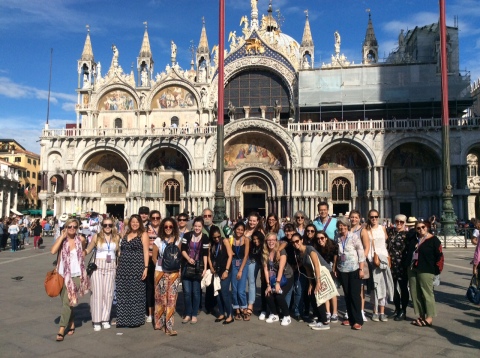
The Aegean Center in front of the Basilica of San Marco, Venice
The past month the Aegean Center for the Fine Arts marked the 28th year of its Italy program. The new group of students arrived in early September at the Villa Rospigliosi, the Aegean Center’s home in Italy. Up in the hills overlooking the Tuscan city of Pistoia, the students became accustomed to life at the Villa; classes throughout the day including drawing, photography, writing and theatre, and sharing prepared meals by the Villa chefs, who have been with the Center since the very first years.
The bulk of the Italy program involves touring the great centers of the Italian Renaissance, including Florence, Siena, Venice, Pisa, Pistoia, Rome and for the first time ever for the Aegean Center, Bologna.
In Florence, the Center was able to visit the newly reopened Museum of the Works of the Duomo featuring a new layout which recreates the facade of the Cathedral with original sculptures set in niches. We toured through the great churches and museums of Florence including the Bargello and the Uffizi. As always, the Brancacci Chapel in the church of Santa Maria del Carmine was a highlight of the tours in Florence. Inside the chapel the group was able to enjoy thirty minutes to themselves to study and admire the great fresco masterpieces of Massacio and Masolino.
On one rainy day, our bus brought us through the Tuscan hills to Siena, where we were fortunately greeted with clearer skies and sunshine. The Cathedral of Siena was less crowded than usual and we were able to admire its incredible array of sculpture and decor, its fascinating floors and the colorful Piccolimini library.
During our second week in Italy, the Aegean Center visited Venice for three days. Upon arriving, art history professor Jeffrey Carson led the tour through the Piazza San Marco and up in to the Basilica of San Marco to see the original bronze horses, taken from the hippodrome of Constantinople. The next day the Aegean Center toured the great painting museum of Venice, the Accademia and found some of our old favorites, works by Giovanni Bellini, Giorgione, and Titian.
After returning to Venice we continued our tours through Tuscany with a visit to Pisa where we enjoyed a bright sunny day in the “Piazza dei Mirocoli,” (the Plaza of Miracles) with its beautiful marble faced buildings: the Cathedral of Pisa, its baptistery, the Campo Santo and of course, the Leaning Tower. In the baptistery, Studio Arts professor Jane Pack described the innovative work of Nicola Pisano’s pulpit and we were able to hear the incredible acoustics of the baptistery interior as one of the guards made a call in to its dome which echoed with his own response.
The Aegean Center visited Bologna for the first time as well. The home of the oldest university in the world, Bologna welcomed us in its rich array of historical and religious centers, including the Basilicas of San Petronio and San Domenico. Although we were unable to see Giambologna’s Fountain of Neptune (under restoration) and Raphael’s Ectasy of St. Cecilia (currently on loan for the Pushkin Museum’s “Raphael. The Poetry of the Image” exhibition) we were taken by the austere beauty of the medieval and premedieval church complex of Santo Stefano and the energy of the city itself.
The Aegean Center students enjoyed our last meal at the Villa Rospigiliosi and thanked the Villa chefs with a thank you card and applause. Saying farewell to the Villa is always bittersweet, a mixture of sadness and excited anticipation with what lays ahead: Rome and finally Greece!
In Rome, director John Pack led the students through a winding tour of Rome’s downtown. John took the students through its famous piazzas, complete with stops for Granita di Cafe in front of the Pantheon and a trip up the Capitoline hill to view over the ancient Roman forum. The next day Jane led the group through the magical Palazzo Massimo to see its treasures including the bronze Pugilist, the dying Niobid and the lovely garden frescoes from the Villa Livia. Finally on our last day in Rome the Aegean Center woke up at the crack of dawn to visit the Vatican museum and where we had the Sistine Chapel all to ourselves, entering before any other group. We all gasped at Michelangelo’s achievements, awestruck and moved.
Rome marked the final leg of the Aegean Center’s Italian tour and the students then departed for Athens. There, under the characteristically bright Greek sunlight, art history Jeffrey Carson led the students up to the Acropolis to see the monument to the magnificence of the Ancient Athenians: The Parthenon. That night, one of the students, Aria Higgins, invited the entire Aegean Center to dine at her family restaurant, Mama Roux. The last day of touring before the students’ arrival in Paros was at the greatest museum of ancient Greek antiquities in the world, the National Archaeological Museum of Athens.
Now the students have all arrived in Paros, to settle in and prepare for the classes ahead. We are all excited to see what else will be accomplished with this close knit, energetic and talented group of students.

Sunrise over the Aegean Sea from the ferry en route to Paros
Thank you very much to Bruno-Ken Shiozawa for the use of his photographs for this post
Dimitra Skandali
25, August 2016 § Leave a comment
By: Jane Pack
Dimitra Skandali is showing recent work at The Aegean Center this summer in her first show since she was a student here many years ago. She is from Paros but now lives and works in San Francisco. She has participated in many international exhibitions. Her website can be viewed here: http://www.dimitraskandali.com/

I imagine this story. Dimitra is walking the shore near San Francisco when a bit of drifted seaweed caught in the sea foam pulls her mind toward Paros. In this expansive space she feels herself to be part of a larger whole. She has come to America to attend graduate school but certainly whatever California offers it isn’t the peaceful calm of Paros in winter. She may have felt alone and displaced for some time after arriving, before the schedule of classes and studios acquired a rhythm to dull the ache for home. I imagine this story because my experience was similar when I left America for a life in Paros over 25 years ago. I too looked for small reminders of the familiar while delighting in the extravagance of the new. Our journeys echo one another’s although we switched places, our paths overlapping for just enough time to recognise each other as fellow travellers.
When one is in a new environment, in a different country from one’s birth, the everyday small occurrences are the ones which pull you up sharply and make you feel an alien, the choice of breakfast foods or the way people queue or don’t. It often comes to perceived differences in manners, knowing when to shake hands or when to exchange kisses. But feeling outside a community can be an advantage as well. We feel immune to social forces, stand outside of society’s demands. In Paros I feel freedom from the small defeats that my parents and teachers may have inadvertently put on me. Whether they implied that a goal was beyond my social standing or that a neighbour might look askance. But in Paros I am excluded from this social weight. I am not Greek so the rules don’t apply. I believe that Dimitra’s success may hinge on a similar impulse. Standing outside the game one sees the rules more clearly. She has taken the best that American education has to offer and she has run with it. Her successes and her show record attest to the conviction that hard work and dedication give results. She has often spoken to me about how much more difficult that same progress would be for her here in her own country.
Dimitra’s work speaks of transitions and patterns, juxtapositions which trigger new thoughts. Her use of natural materials echo the smells and sounds of the sea, of the Aegean, of the Pacific. The rooms full of seaweed invite us to feel the ocean swells but also admire the handiwork of traditional crafts in the in the crocheted strands. Delicacy and energy, it is this combination which strikes us.
Dimitra was my student over 20 years ago. She has since long surpassed my mentoring and has made a name for herself in the international art world. Her return to the Aegean Center for this exhibition coincides with the 50th anniversary of the school. I can’t think of a more fitting tribute to our mission than to have this exhibition by a Parian, a former student and who has gone on to succeed in America and beyond. What I experienced coming to Greece and the similar feelings that Dimitra has translated into her art epitomize the education we provide at the Aegean Center. The strength of the experience at the Center comes from a combination of dedicated teachers and the disorienting effects of living in an unfamiliar environment. The mind opens up, the habitual patterns are broken and the teacher has only to ask the questions which lead the student on to new ground. The subsequent shift in consciousness helps us to see within ourselves and tap into the creative spirit.
Figure Drawing Workshop
19, July 2016 § Leave a comment
Jane Morris Pack

Model in “Plane Suit”
Learning to draw the human figure is a challenge and demands a clear understanding of how to capture form. It is also a difficult task to do in two weeks but the eight students attending the Intensive Summer Workshop did an amazing job of pulling it all together in a short time. We worked from the model for two hours every morning and then after lunch the projects included working in clay and drawing the bones and muscles. Learning to draw the basic geometric forms was given particular attention as they are the building blocks for all form. We investigated perspective, built a clay head, foot, hand, nose and mouth. The students traced their own proportions life size on paper and then added the skeleton and muscles to those drawings. On the final day, as a creative exercise, we hung paper cutouts onto a line and played lights over their forms to suggest movement.
Since drawing is such an intense activity we needed a few distractions to smooth the steep learning curve. One night was spent watching the stars appear from a vantage point high on the mountain after sunset, on another we had a wine tasting of six prominent Greek varietals, and lastly a full day was enjoyed on a wonderful boat trip around the neighbouring island of Antiparos. Thank you to all of my wonderful and enthusiastic students from whom I learn so much.
- Jane Teaching
- Drawing From the Clay Hand
- Muscles & Bones Exercise
- Drawing on Black Paper
- Figure Cutouts
- Working Studio
Annelise Grindheim’s Drama
10, July 2016 § 1 Comment
by: Jeffrey Carson
The origins of drama are mysterious. But my intuition suggests that all drama starts in awe of the world, its powers and unseen powers, its passions and irresolutions. Drama has its roots in religion, cult, magic, poetic rapture, birth/sex/death, and natural wonder. I think this is true of anonymous Passion plays from the Middle Ages, Shakespeare’s investigations of everything human and beyond, ghostly Japanese Noh, rollicking Restoration comedy, throbbing opera, and even the great realist works of the last century-and-a-half, whose master is Henrik Ibsen.
I did not mention ancient Greek plays because these astonishing works – we have thirty-two of them – seem to know this about themselves, and consciously embed themselves in primitive ritual and, with music and poetry, political realism.
The Aegean Center’s drama teacher, Anneliese Grindheim, knows these things, and her love and understanding of the Greek plays informs her work here on Paros. Last autumn she produced a condensed version of Lorca’s frightening tragedy, “The House of Bernarda Alba”, which, in image-loaded verse, shows what happens when society’s rules try to squelch the natural joy and passion of life. Working with small forces – students and a few local friends – Annelise trimmed the work to its essentials – she has an amazing ability to do this with respect and accuracy.

Annalise Grindheim
This spring’s work was even more ambitious. It was Ibsen’s “Lady from the Sea”, a realist drama. Redacting again, Annelise found the poetry and intensity curled deep in the Norwegian master’s realism (she is Norwegian herself). The play is a liminal work, and we are never sure what will happen as the symbols keep being transformed. The actors performed it on the beach, sometimes on sand, sometimes in water. The growth of the heroine’s soul and self into maturity, and its salutary effect on her husband, were aided by movements derived from dance, by declamation derived from poetry, by masks, and by the sea itself – wavelets, gulls, breezes, briny clarity. Liminal indeed.
I’m fortunate to work at the Aegean Center with such skilled practitioners of their arts as John Pack, Jane Pack, Jun-Pierre Shiozawa, and most recently, Annelise Grindheim. What will she come up with next? I may write a poem about it.


